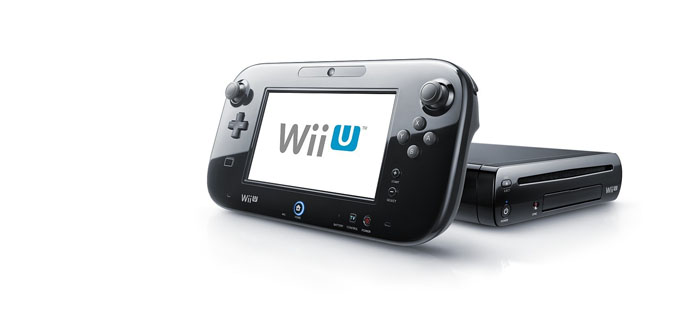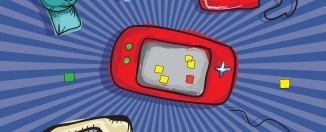A Wii U Review by Nintendo fanboy shake_zula
As a devoted Nintendo fan, I was pretty upset when the Wii U was first unveiled at E3 2011. Satoru Iwata’s promise that, this time around, Nintendo was making a console to target “core gamers,” echoed mockingly in my mind as I stared glumly at the tablet-esque controller. We were promised a core gaming experience., but one with a touch screen?
“Just another gimmick,” I typed angrily on internet forums later that night. “No better than motion controls!” I roared from the bedroom to my thoroughly uninterested girlfriend over the next few weeks, as I watched more and more pictures surface.
And sometimes, deep into the night’s darkness, huddled in the corner of a dimly lit tavern, I would whisper, with clenched fists and eyes full of treason, “I’m not getting one.”
Fast-forward eighteen months and there I was, collecting my pre-ordered Wii U Premium pack from Blockbuster on launch day. I had not rid myself of the cynicism, but instead taken on a weary acquiescence to the situation. I’ll buy anything that Nintendo releases, I realise that now. There is a picture circulating the internet, depicting Nintendo of America’s president Reggie Fils-Aime defecating onto a horde of Nintendo fans, as he exclaims “They love it!” I recognise myself in that horde. I hated the Wii’s graphical limitations, useless online network, and most of all, evil motion controls, but I bought one anyway, because, as always, I wanted to play Mario Kart, Smash Bros., Zelda, Metroid, Mario Galaxy, Donkey Kong and Kirby. I assumed the Wii U would be a similar story – awful hardware, great games. Read on to see if I was right.
Aesthetics and Ergonomics
The Wii U is an attractive console. Like a bigger, curvier Wii, the black model is demure but elegant. The blue, red, and white LEDs look more sophisticated than the greens or ambers that are often found on consoles. And, when powered on, the machine hums very softly. The only gripe to be had here is that it picks up fingerprints easily.
The Gamepad is surprisingly nice. It looks too wide to be comfortable, as if your hands would be spaced unnaturally far apart, but it’s actually pleasant to hold in most situations. The buttons feel of reasonable quality, the sticks provide a good amount of resistance (although they are convex rather than concave – a personal niggle), and the D-pad is far better than that found on the Dual Shock or Xbox 360 controller. The touch screen is as good as can be expected – Nintendo went for a resistive rather than capacitive screen, which means that multitouch functions such as pinching aren’t available, but this approach helped keep the cost down. I’m pleased with the Gamepad’s quality, although anyone expecting similar responsiveness to a modern smartphone screen will be disappointed.
The button layout isn’t perfect. I find that holding the Gamepad with all four shoulder buttons covered by four fingers is uncomfortable after a while, resulting in the thin sides of the pad pressing into my palms. In addition, holding the pad in this way means that the four face buttons, placed below the right analogue stick, become very difficult to access, especially A and B. I prefer to hold it with only my index fingers covering all the shoulder buttons; however, the buttons are set quite far apart, meaning that to move my index finger from ZR to R (think R2 to R1) is more of a stretch than it should be. Comfort is, of course, an extremely subjective issue, and I do have inordinately large hands. Finally, the ZR and ZL triggers are not analogue, they merely click in and out like all of the other buttons. This is only really an issue for racing game enthusiasts who need to mimic pedal pressure, but it’s worth pointing out.
The Pro Controller is pretty good, with the same sticks and buttons that can be found on the Gamepad, but with a shape and design comparable to a 360 controller. Its only unique feature is that the face buttons are positioned lower than the right analogue stick, in line with the d-pad. Whether this is comfortable is something you’ll have to decide for yourself, but otherwise the Pro Controller does its job well.
Capability
If you consider the Xbox 360 and PlayStation 3 to be generally on par in terms of power and performance, you can pretty much stick the Wii U into the same bracket. Broadly speaking, it has more memory than its competitors, but its CPU has a slower clock speed. The technology is more modern, of course, so this doesn’t really tell the whole story. In benchmarks of multi-platform games such as Assassin’s Creed III and Arkham City, the Wii U tends to fall above the PS3 but below the 360 in terms of framerate. In terms of visual flair, it’s difficult to call – Nintendo’s machine does some things better and some things worse than its counterparts, but overall it’s generally up to speed.
The elephant in the room at this point is the fact that the PlayStation 3 and Xbox 360 were released six and seven years ago respectively, and you can now buy a 360 for £149.99, a full hundred pounds less than the Wii U’s Basic model. With modern technology and manufacturing, a machine of similar specification to a seven year old model should be a lot cheaper – certainly not more expensive. The reason for the Wii U’s price is the Gamepad. Although it’s not actually available for purchase yet other than in the box along with a console (so if you get one, don’t break it), when it’s eventually released as a separate peripheral, it’s projected to cost well over £100 (so if you get one, don’t break it). I can’t help but wonder if this console would have done better if it were launched with a traditional controller at £179.99, along with a big first-party title such as Zelda, Metroid Prime, or 3D Mario.
The Wii U comes with pretty limited storage – the 8GB Basic model actually leaves you with only 3GB of usable space, since the operating system takes up most of it. The 32GB Premium model similarly leaves you with 25GB from the off, which should be OK for most people, unless you’re planning on downloading full retail games (not a great idea anyway, since boxed copies can always be found cheaper). The Wii U thankfully supports all USB hard drives, so you’re not restricted to buying expensive proprietary storage. Still, it seems odd that a model with more space isn’t offered.
A final thing to note of the hardware is that again, Nintendo have opted to not pay for a DVD or BluRay license, so watching films on your console will be limited to what’s on Netflix or LoveFilm.
Playability and Controls
Here comes the big question: Does the Gamepad genuinely offer an improvement over traditional control methods? Or is merely it another worthless gimmick that will actually damage games due to touch functionality being needlessly shoehorned in by overzealous developers?
It’s too early to know for sure, as it obviously depends on how the feature is applied within games, and we don’t have many to assess at present. So far though, I have to say that it is very promising. The Gamepad screen is a convenient place to have a map or radar, and it makes navigating menus and inventories quicker. It also makes certain in-game mechanics and minigames easier and more engaging. In ZombiU, the screen adds a layer of tension and immersion that wouldn’t otherwise be possible, as you are forced to use your inventory on the Gamepad without the game being paused, fearfully glancing back up at the TV every two seconds to check for approaching zombies. I’m particularly looking forward to playing Aliens: Colonial Marines and hearing that ominous radar beep in my clammy, quivering hands.
Terrible, game-breaking touch controls will inevitably arrive at some point, but it seems right now that they’re going to be the exception rather than the rule. And of course, we can’t forget the Gamepad’s crowning glory – you’re able to play games directly on its 6.2” screen, while the TV is off or showing another channel. You just need the console switched on and within range (if it can’t reach from your lounge to your bedroom then you clearly have a large house, and can afford to buy a console for each room anyway).
Online Functionality
This is the one area where the Wii U really lets itself down. Like the Wii and 3DS before it, the online accounts are tied to the console. You can’t log in to your Nintendo Network account, or play your digitally purchased content, on any Wii U other than the specific console that you created the account on. It is possible for data to be transferred from one console to another, but this procedure can only be performed by Nintendo. So, there will be no taking your Wii U to your local shop to be repaired. For those of you with the large houses , no playing your downloaded games on that secondary console in the bedroom. And what happens when a Wii U Slim comes out and you want to upgrade? You have to send your console off to Nintendo, then wait for them to perform a data transfer and send it back to you. This is absolutely inexcusable, and it’s an issue that desperately needs to be patched out. Microsoft and Sony have been getting it right for years. The only good thing that Nintendo has done with their online network is to get rid of the awful Friend Code system employed on the Wii, but that’s simply rectifying a problem that they should never have created in the first place.
On a more positive note, MiiVerse is fantastic. This is a social network that Nintendo have created to be accessed from the console. It works like a Facebook news feed, except there is a different “board” for each game or application available for the Wii U, and you see the posts of everybody, rather than just your friends. There’s no general or off-topic board, which means that almost all of the discussion is game-related (this is a good thing). You can either draw a picture on the touch screen or write a 100-character message, with the option to tag your post as a spoiler. The network is thriving at the moment, and I’ve found myself spending hours on there, just talking about games and reading what people have to say.
You can also pop in and out of MiiVerse during your game to ask fellow players for tips, a method of acquiring help which feels a lot more honourable than looking it up on Gamefaqs or YouTube, especially if you return the favour by helping out someone else. If you need to search deeper for information though, it’s just as easy. The Wii U’s web browser is excellent and can also be accessed without leaving your game, with the ability to view almost all web content other than Flash (don’t worry, there’s an external YouTube application pre-installed). The ease and fluidity of this really needs to be experienced to appreciate, but it’s a fantastic feature.
Conclusion
The Wii U is a great console. My pre-launch fears have been proved wrong, and I am looking forward to many happy years with it. However, is the Wii U worth buying?
The answer at this stage is probably not. There are few exclusive titles on the immediate horizon, and the price is high. If you already own an Xbox 360 or PlayStation 3, I recommend waiting for either a price drop and/or more exclusive games.
Nintendo has done enough to please me, but perhaps not enough to please everybody.








I think my main problem with Nintendo consoles nowadays is that there are very few games that I’m interested in buying. Super Smash Bros. is always good fun but it’s a very multiplayer game and with the reputably poor internet quality shown in Brawl, I can’t justify buying a console for that one game. Another problem is finding interesting exclusives on Nintendo consoles. Some of the most fun I had on the Gamecube were third party titles but I honestly can’t think of a third party title that I really wanted to play/buy for the Wii.
Nintendo is very good at making games and consoles for families or for people who have their friends over a lot but offer very little for people who just want to play with themselves (haa….).
People who bought it are given free video tutorials that show
them how to use it without any experience in making music.
Pro Tools, Cubase, Nuendo, SONAR, Acid, Digital Performer, & Logic.
The large buffer would therefore be used when mixing because latency is irrelevant and there is no reason not to go for maximum
stability.
This applies to customer service, teamwork, and leadership.
I’ve met some truly amazing people and have
received so many opportunities through SG. We’re a community, a social networking site, and so much more than just alt-porn.
When someone writes an paragraph he/she maintains the image of
a user in his/her mind that how a user can understand it.
Therefore that’s why this paragraph is outstdanding. Thanks!